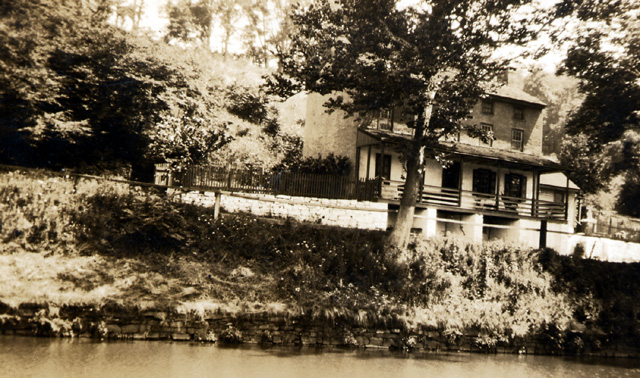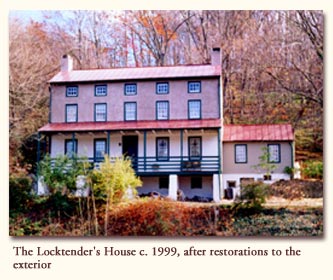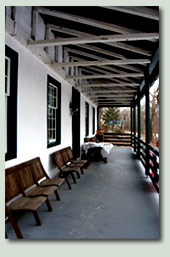-
-
-
-
-
-
-
-
Locktender's House
-
-
-
-
-
-
The Locktender's House, built during the navigation's first expansion period, 1836 to 1839, was home to the lock tender and his family. It sits on the high bank on the land side of the canal and overlooks Lock 60 and the head of the canal. This simple stucco-over-fieldstone house has three stories. Each floor has a central hall with one room on each side. The third floor is under a steeply pitched roof, and all the windows are under such low eaves that they were given the nickname "belly windows" because one had to lie on one’s belly to look out them. The house has plank floors, four fireplaces, and, except for the third floor, 8-foot ceilings. Runoff from the steep hill behind the house is so severe that during the days of the last lock tender, wooden walkways w ere laid all around the house. ere laid all around the house.
During the active canal era, the lock tender and his family were as self-sufficient as possible. The remains of a hand-dug well, an outhouse, a smokehouse and a small barn have been found on the downstream end of the property. Field crops were grown in the area between the canal and the river, and vegetables, herbs and flowers were raised around the house. All products grown or made at home could be sold to or bartered with the passing boats. Running water was not brought into the house until the early 1930s. Timbers from the lock were used as beams to support a one-story kitchen wing containing a sink and pump. The privy remained outdoors.
Emmanuel Schaeffer was the last lock tender who lived in the house with his widowed sister, Ethel Croll, when the state came into possession of the navigation in the 1949. They continued to live in the house until the early 1970s and eventually moved after it became too hard fo rthe elderly residents to maintain the house and grounds. At that time the house was boarded up and left to neglect. In 1983, when Upper Providence Township became the lessee and the Association joined it in takling responsibility for the area, the house had been badly vandalized over 10 years time. Their first move was to make the house minimally livable and install a tenant. The kitchen was modernized and the indoor bathroom and furnace installed. Over the next dozen years Association volunteers made many other modest improvements. All the tenants were also active SCA members and volunteers. Once the state and other agencies began supporting heritage corridor projects, SCA chose the Locktender’s House as its first major restoration program. Over a period of five years all exterior woodwork, including 25 window sashes, porch and front door, were either repaired or replaced. The entire exterior was repainted and restuccoed, and the yard was beautifully landscaped.
Access to the house was greatly improved, including channeling the runoff from the hill behind the house into underground conduits and laying field stone walkways to the front porch and back yard. The old stone steps cut into the steep bank on which the house sits were rebuilt to a moderate grade, and provided with hand railings and ground lights.
|
The Locktender's House: TODAY The house is The Open House provides an opportunity for the public to take a brief tour of the house free-of-charge. There is ample seating for visitors on the front porch and the first-floor living room, and both downstairs rooms have exhibits, historic photographs and documents, a library about canals, information about regional heritage corridor activities, events schedules and various books and souvenir items for sale. The living room even has an old player piano that belonged to the Schaeffer family, the last locktender. Public restrooms meeting American Disabilities Act standards are located in the maintenance garage south of the Locktender’s House, with an adjacent handicap 2-car parking area. Montgomery County has extended the Schuylkill River Trail west from the mouth of the Perkiomen to the Longford Road Trailhead in Port Providence where it meets the end of the canal. Lock 60 is a short 2.5-mile bicycle ride from the trailhead. SCA installed Interpretive signs for the area’s main historical landmarks, so visitors have a better appreciation for what they are looking at. Plan to stop in at the Locktender's House, when open, to learn more about the history & heritage of the area, get questions answered and to generally feel welcome at Lock 60 on the Schuylkill Canal.
|


 now the Schuylkill Canal Association’s Visitors’ Center and the hub for many programs and events. The house is open to the general public on the third Sunday each month, from 1 PM to 4 PM except in June (Canal Day/last Sunday in June, and December for the Holiday Luminaria) and by appointment.
now the Schuylkill Canal Association’s Visitors’ Center and the hub for many programs and events. The house is open to the general public on the third Sunday each month, from 1 PM to 4 PM except in June (Canal Day/last Sunday in June, and December for the Holiday Luminaria) and by appointment. 